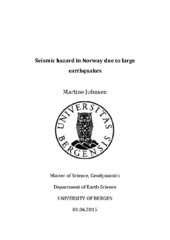Seismic hazard in Norway due to large earthquakes
Master thesis
Permanent lenke
https://hdl.handle.net/1956/10269Utgivelsesdato
2015-06-01Metadata
Vis full innførselSamlinger
- Department of Earth Science [1033]
Sammendrag
There are many faults located in Norway, posing as potential earthquake sources. Even though the seismicity is characterized as low to moderate, earthquakes of magnitude 3.5 or lower occur regularly. The seismic hazard following such a small event is very low; however, the occurrence of small earthquakes may promote the possibility of larger events. This thesis is based on the potential seismic hazard in Norway due to large earthquakes, and this study performs simulations of three or four different earthquake scenarios on 13 faults located in Norway, in areas where cities and towns are situated nearby, and these magnitudes are: the highest possible magnitude for each fault based on the fault length (ranges from MW 7.7 to MW 6.9), MW 7.0, MW 6.5 and MW 6.0. The simulations show the expected ground motion in peak ground acceleration (PGA), and the PGA caused by the earthquake scenarios are quite high, with a maximum of 317.6 cm/s2. This could correspond to shaking of intensity VIII on the Modified Mercalli Intensity Scale. The MW 6.5 and MW 6.0 scenarios would result in PGA between 191.4 and 91.11 cm/s2, which may indicate intensity VI - VII. The area outside the 50 cm/s2 contour line would be exposed to PGA below 50 cm/s2 and the shaking in this area could correspond to intensity IV - VI. A stochastic simulation code, EXSIM12, was used in performing these simulations. The difference in maximum PGA for scenarios of similar magnitude shows that the distribution of the PGA and the maximum value are dependent on several factors, for example the length and width of the fault, as well as the number of iterations per site, and whether the simulations are performed with random or fixed hypocenter location. Both increasing the number of iterations per site and changing from random to fixed hypocenter location result in smoother distribution of the PGA and lower maximum value for the earthquake scenarios.
